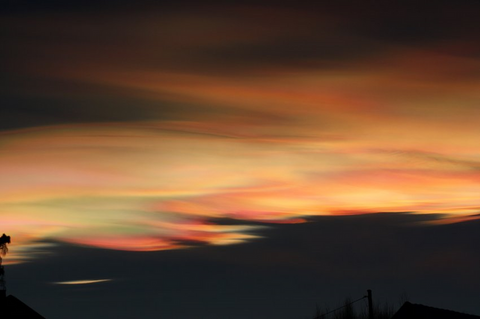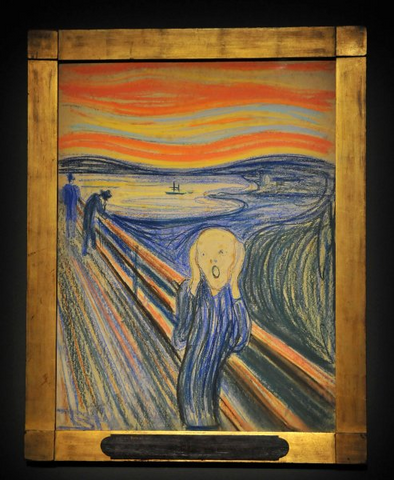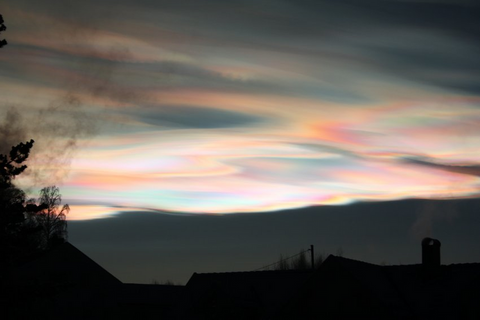Meteorologists explain The Scream
Was Edvard Munch seized by panic at the sight of "screaming clouds?"


"I was walking along the street with two friends – and the sun set. Suddenly, the sky turned blood-red and I felt a shiver of sadness. A feeling of oppressive pain in my breast.“ This is how the Norwegian painter Edvard Munch described the state of feeling which he translated into his famous painting The Scream.
"I stopped in my tracks, leaned against a fence, because I felt tired to death. Above the blue-black fjord and the city, blood lay stretched out in tongues of fire. My friends proceeded ahead – and I found myself left behind, trembling with fear. And I felt that a mighty, endless scream was tearing through all of nature."
Had Munch at that time in Oslo turned his insides out in his famous painting, as art theoreticians believe? Venting a fear of life, or of death? Was The Scream an image of the state of his soul? Or was there an external trigger for his work?
Indeed, there could have been such, meteorologists have been guessing for some time. Munch‘s Scream may have been inspired by the aspect of the sky, a gigantic cloud of ashes having spewed forth from the Krakatoa volcano in Indosia and having spread around the world in 1883, giving the sunlight a reddish cast for two years, or more. It is quite possible therefore that the painter may have seen this „blood in tongues of fire“ appearing in the sky as a real phenomenon.
However, the eruption took place nine years before Munch is said to have painted The Scream. And something else did not fit quite right with a volcano-colored sky: Munch painted dramatic, red waves – but particles of ash at the borders with space are glowing as a solid, red film.
Meteorologists are now proposing a new explanation: it had been a special, rare kind of cloud which had colored the sky of Oslo in this way and produced such a deep impression on Munch. "Mother-of-pearl" clouds, which appear rarely and only in winter at high latitudes, at heights of 20km, resemble the sky-waves represented by Munch, according to a group of Norwegian scientists.
Munch's panic can be best explained by mother-of-pearl clouds, Helene Muri from the University of Oslo explained at the annual conference of the European Geosciences Union (EGU) in Vienna, where she presented the results reached by a scientific team gathered around her colleague, Svein Fikke.
The volcanic tinted sky, Muri explained, would not have looked like anything unusual at the time, as the veil of ashes persisted for circa two years. On the other hand, few people ever get to see mother-of-pearl clouds, so rare is the phenomenon. They could well etch correspondingly strong impressions into the human soul; scientists speak of „screaming clouds.“
Mother-of-pearl clouds occur when the light of the sun, after sunset or before sunrise, shines on a thin veil of tiny crystals high up in the sky. After about half an hour after sunset, or when the sun rises, the glow vanishes: either night falls, or the sun, appearing in the sky, outshines the mother-of-pearl clouds – they become invisible.
The veils of crystal form only at times of extreme cold in winter, when ascending currents lift tiny droplet into the stratosphere, where they freeze. Such winds occur most often near mountains. However, this is also where normal clouds often form, which hide the sight of the mother-of-pearl clouds.
This new theory could create a furor, as was hinted at by the reaction of a flustered journalist at the EGU conferenze in Vienna „Why,“ she asked Muri harshly, „must you bring yet more disorder into this affair? „
The researcher answered nonchalantly: „It’s our job to second guess occurrences.“ Art experts and psychologists have all latitude to bring forward their own interpretations of the famous painting. But as natural scientists, these surprising coincidence between nature and a work of of art had sollicited their attention.
Axel Bojanowski
Der Spiegel, April 24, 2017
Translated (from the German) by Anne-Marie de Grazia


